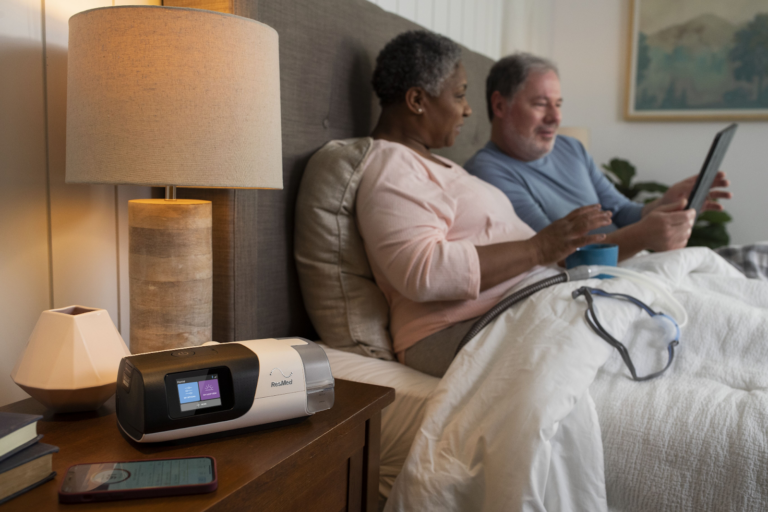Your cart is currently empty!
Prefer to just call? (07) 3472 6421
|
The Ultimate CPAP Cleaning Routine: Keep Your Machine Fresh, Safe, and Long-Lasting

Every night, your CPAP delivers air pressure for hours at a time, and even light residue from skin oils, condensation, or dust can slowly affect how it performs. When airflow weakens or moisture stays trapped inside, irritation, noise, and odour soon follow.
Consistent cleaning prevents those problems before they start. It keeps pressure levels stable, seals tight, and fresh air quality. More importantly, it extends the life of your mask, tubing, and filters, saving you from early replacements and performance drop-offs.
At Sleep Warehouse, we believe caring for your CPAP should be simple. This guide walks you through a structured cleaning routine that takes only a few minutes each day but helps your machine stay dependable for years.
The CPAP Cleaning Schedule
A regular cleaning routine is the simplest way to maintain performance and prevent hygiene issues. Each stage has a purpose: daily cleaning removes surface residue, weekly care targets hidden build-up, and monthly checks ensure the system continues to operate smoothly.
Daily Care (Two to Five Minutes)
Short daily cleaning habits keep your CPAP ready for consistent use.
✔ Wipe the mask cushion and tubing with warm water and mild soap immediately after use.
✔ Empty the humidifier chamber every morning to prevent bacteria and mineral deposits.
✔ Leave all parts to air-dry on a clean surface before reassembly.
These small steps prevent moisture from collecting in the mask and tubing, which can otherwise lead to unpleasant smells and discomfort during the night.
Weekly Care (Twenty to Thirty Minutes)
Weekly deep cleaning removes residue that daily wipes cannot reach.
✔ Disassemble the mask, hose, and water chamber, then wash each piece in a basin of warm soapy water or diluted vinegar solution.
✔ Rinse thoroughly to remove any traces of cleaning solution.
✔ Dry all components completely before reconnecting them.
This level of cleaning helps prevent bacterial growth and keeps the air pressure consistent. It also reduces the wear on seals and cushions, which often deteriorate faster when exposed to oil or detergent residue.
Monthly Maintenance (Ten Minutes)
Monthly maintenance ensures the entire setup remains reliable.
✔ Inspect the tubing for stiffness, cracks, or cloudy spots.
✔ Check the mask seal for damage or loss of flexibility.
✔ Replace filters or disposable parts according to your model’s instructions.
✔ Clean the machine exterior with a soft cloth to remove dust.
These checks protect the system’s airflow and efficiency while extending the lifespan of essential parts. Consistency in these simple tasks keeps your CPAP performing at its best night after night.
Safe Tools and Cleaning Agents
Using the correct tools and cleaning products ensures that your CPAP stays clean without risking damage to the materials. Avoid harsh chemicals and stick to safe, proven options recommended by both manufacturers and healthcare professionals.
Recommended Tools
✔ A soft CPAP brush for cleaning inside hoses.
✔ Lint-free cloths for surface wiping.
✔ A dedicated basin or container for soaking parts.
✔ Distilled water for rinsing and for the humidifier chamber.
These tools make it easier to maintain a consistent routine while avoiding scratches or material fatigue.
Safe Cleaning Agents
Gentle products are most effective for regular use.
✔ Mild soap mixed with warm water is suitable for daily cleaning.
✔ A vinegar solution of one part vinegar to three parts water provides effective disinfection during weekly cleaning.
✔ Hydrogen peroxide may be used occasionally for stubborn residue, provided that all parts are rinsed thoroughly and air-dried.
Avoid bleach, alcohol-based cleaners, or products with perfumes, as they can damage silicone and affect air quality.
Practical Alternatives
When travelling or pressed for time, alcohol-free baby wipes or purpose-made CPAP wipes provide a quick and safe cleaning option. Basic household dish soap also performs well for daily care when used sparingly and rinsed properly.
Each of these methods keeps your machine clean without introducing chemicals that degrade seals or tubing. For additional guidance or cleaning kit recommendations, Sleep Warehouse staff can assist with products compatible with your CPAP model.
Step-by-Step CPAP Cleaning Process
The correct cleaning process protects both the device and the quality of your sleep. Following these steps in order ensures thorough hygiene without damaging delicate parts.
1. Disconnect and Prepare
Turn off and unplug the CPAP machine. Disconnect the mask, tubing, and water chamber. Gather your cleaning materials before starting.
2. Wash and Soak
Fill a basin with warm water and a small amount of mild soap. Submerge the tubing, mask, and water chamber completely. Allow them to soak for ten to fifteen minutes to loosen residue.
3. Scrub and Rinse
Use a soft CPAP brush to gently clean the inside of the tubing and any tight corners of the mask. Rinse all parts thoroughly with clean water until no soap or scent remains.
4. Air-Dry Thoroughly
Place all components on a clean towel and allow them to dry naturally. Keep them away from direct sunlight or heat sources, as high temperatures can deform plastic and silicone.
5. Reassemble and Inspect
Ensure each part is completely dry to the touch before reconnecting. Inspect the seals and filters for wear or debris. Once everything is clean and secure, reconnect the power and store the machine in a dry, dust-free area.
Regular adherence to this process keeps airflow strong and prevents common performance issues such as increased noise or condensation inside the hose.
Mistakes That Damage Your CPAP
Even small cleaning errors can shorten the life of your equipment. Understanding what to avoid is just as important as knowing how to clean.
Using Tap Water for Extended Periods
Tap water leaves mineral deposits that can harden and damage the humidifier chamber. Always use distilled water to maintain purity and prevent scaling.
Skipping Drying Time
Reassembling parts while damp allows bacteria and mould to develop. Every part must be fully dry before use.
Using Harsh or Alcohol-Based Cleaners
Bleach, alcohol, and scented detergents degrade silicone, causing cracks and leaks. Stick to mild soap or approved cleaning solutions.
Overtightening Mask Components
Tightening straps or seals excessively after cleaning causes stretching and early wear. Secure parts gently to maintain a proper fit without pressure marks.
Ignoring Signs of Build-Up
Visible residue or cloudy tubing is a signal to clean immediately. Leaving it unattended affects air quality and can lead to equipment malfunction.
Maintaining a careful approach protects both your comfort and your investment. For questions about safe cleaning techniques or compatible accessories, Sleep Warehouse provides professional guidance for all major CPAP brands.
When to Service or Replace Equipment
Regular cleaning extends the life of your CPAP, but every component has a practical limit. Knowing when to replace parts ensures that therapy remains effective and comfortable.
Typical Replacement Intervals
| Component | Recommended Replacement Interval |
| Mask Cushion | Every 3 to 6 months |
| Air Filter | Every 1 to 2 months |
| Tubing | Every 6 to 12 months |
| Water Chamber | Every 12 months |
Replace parts sooner if they show visible wear, stiffness, or changes in texture. Fresh components maintain a secure fit and prevent air leaks that interfere with pressure consistency.
When Servicing Becomes Necessary
If the machine produces unusual noise, fluctuating pressure, or an unpleasant smell even after cleaning, it may require servicing. These symptoms usually indicate internal residue or filter obstruction. A technician can inspect and recalibrate the system to restore proper performance.
Professional Support from Sleep Warehouse
Sleep Warehouse provides genuine replacement parts for leading brands such as ResMed and offers professional advice to help match compatible components. If servicing is required, our team can assess the condition of your device and guide you on whether cleaning, part replacement, or a full service is the best option.
Regular attention to maintenance saves both time and cost, ensuring therapy remains consistent and reliable.
Common Signs of Neglect and Quick Fixes
Consistent cleaning prevents most CPAP issues, but even experienced users occasionally overlook details. Recognising early warning signs helps prevent larger problems.
Unusual Smell or Taste
A stale or musty smell indicates bacterial growth inside the tubing or chamber. Clean and rinse all parts immediately. Replace the filter if the smell persists.
Louder or Irregular Noise
Increased sound levels often result from minor air leaks, loose connections, or debris build-up. Check the mask seal and hose fittings, and clean thoroughly before use.
Reduced Air Pressure or Weak Flow
A clogged or dusty filter can restrict airflow. Replace it promptly and ensure the hose is free from bends or condensation.
Visible Mould or Residue
Dark spots or cloudy build-up inside the hose or chamber suggest trapped moisture. Replace affected parts to maintain hygiene and air quality.
Persistent Dryness or Irritation
Dry air can mean that the humidifier setting is too low or the chamber is not cleaned regularly. Empty, rinse, and refill the chamber daily with distilled water.
Early intervention prevents long-term damage. If your machine continues to perform poorly after cleaning, the Sleep Warehouse team can assist with troubleshooting and recommend the best next steps.
Consistent Care for Better Sleep
Clean equipment keeps therapy dependable, comfortable, and safe. A few minutes of maintenance each week prevents issues that interrupt rest and shortens the lifespan of your device. Once cleaning becomes routine, the results are immediate: quieter nights, fresher airflow, and uninterrupted comfort.
Sleep Warehouse provides the tools and guidance to make that routine simple. Whether you need cleaning supplies, filters, or professional servicing, our Cairns-based team supports CPAP users across Australia with practical solutions that keep therapy working as it should.
Shop CPAP Cleaning Supplies and Replacement Parts at Sleep Warehouse
Frequently Asked Questions
1. How can I tell if my CPAP parts are genuinely clean?
After cleaning, the surfaces should feel smooth and free from residue. A clean hose or mask should have no visible film, odour, or moisture. If smells persist or airflow feels restricted, rewash and allow longer drying time before use.
2. Can I use a CPAP cleaning machine instead of manual washing?
Automated cleaners can supplement regular care but should not replace hand cleaning. They often miss certain components or fail to remove residue completely. Manual washing remains the most reliable way to maintain hygiene and prevent warranty issues.
3. What should I do if I miss a few cleaning days?
Resume the full cleaning routine immediately and inspect for residue or discolouration. If there are signs of mould or odour, replace filters and soak all removable parts before the next use. Sleep Warehouse can assist with identifying any components that need replacement.
4. How often should a CPAP machine itself be serviced?
Most machines benefit from a professional service every twelve to eighteen months. Servicing ensures correct pressure output, internal cleanliness, and component calibration. Our technicians at Sleep Warehouse can assess your device and advise whether a service is due.
ABOUT AUTHOR



Leave a Reply
You must be logged in to post a comment.